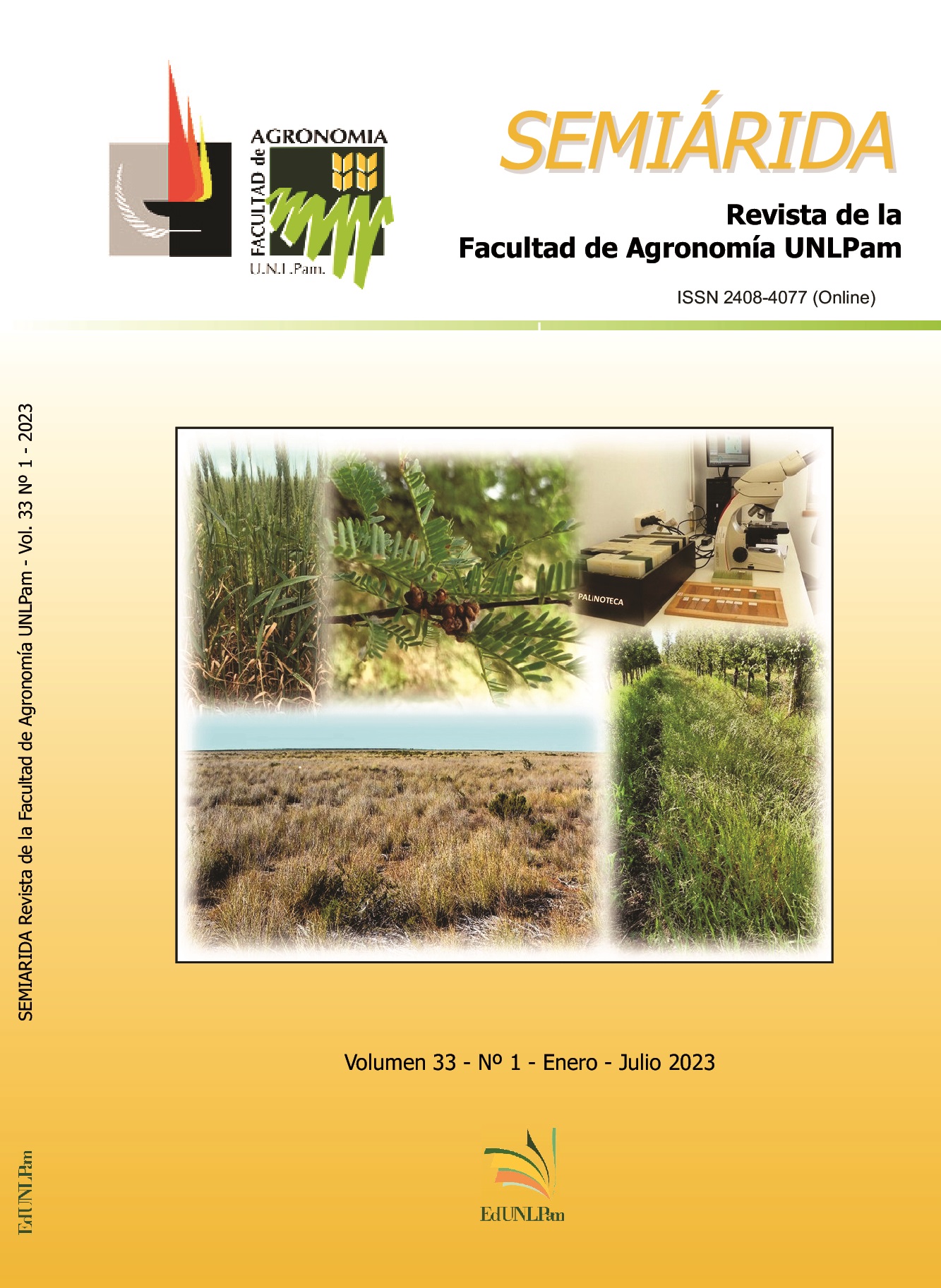Ver ítem
- xmlui.general.dspace_homeCentros Regionales y EEAsCentro Regional La Pampa - San LuisEEA AnguilArtículos científicosxmlui.ArtifactBrowser.ItemViewer.trail
- Inicio
- Centros Regionales y EEAs
- Centro Regional La Pampa - San Luis
- EEA Anguil
- Artículos científicos
- Ver ítem
Efecto de distintas fuentes de fósforo y su interacción con nitógeno sobre el rendimiento y calidad de trigo
Resumen
El objetivo del trabajo fue evaluar el efecto de distintas fuentes de fósforo y su interacción con nitrógeno, sobre el rendimiento, calidad y extracción de nutrientes del cultivo de trigo. El ensayo fue llevado a cabo sobre un Haplustol éntico, en el cual se establecieron 8 tratamientos (T) de fertilización. El T 1 corresponde al testigo (sin agregado de P), en los T 2, 3, 4 y 5 se aplicó 18,3 kg. ha-1 de P. Los T 6, 7 y 8, corresponden a fertilizantes
[ver mas...]
El objetivo del trabajo fue evaluar el efecto de distintas fuentes de fósforo y su interacción con nitrógeno, sobre el rendimiento, calidad y extracción de nutrientes del cultivo de trigo. El ensayo fue llevado a cabo sobre un Haplustol éntico, en el cual se establecieron 8 tratamientos (T) de fertilización. El T 1 corresponde al testigo (sin agregado de P), en los T 2, 3, 4 y 5 se aplicó 18,3 kg. ha-1 de P. Los T 6, 7 y 8, corresponden a fertilizantes que se recomiendan utilizar a razón de 30 kg. ha-1, lo que corresponde a la aplicación de 5,25 kg de P.ha-1. En parcelas divididas, se establecieron dos manejos del nitrógeno, sin fertilización y con fertilización. En todos los tratamientos con fósforo el agregado de N presentó diferencias estadísticas significativas en rendimiento. La eficiencia de uso del agua fue mayor en aquellos T cuyos fertilizantes poseen una formulación balanceada de nutrientes. No se encontraron diferencias significativas en concentración de proteína. Los T 2, 3, 4 y 5 presentaron balance positivo entre el P aplicado con fertilizante y extraído en el grano, los T 6, 7 y 8 tuvieron balance negativo, mientras que el T 1 (testigo) fue la peor situación.
[Cerrar]
The objective of this work was to evaluate the effect of different sources of phosphorus and its interaction with nitrogen, on the yield, quality, and nutrient extraction of the wheat crop. The field experiment was carried out on an entic Haplustol, in which 8 fertilization treatments (T) were established. T 1 corresponds to the control (without adding P), in T 2, 3, 4, and 5, 18,3 kg.ha-1 of P was applied. T 6, 7, and 8 correspond to fertilizer additions
[ver mas...]
The objective of this work was to evaluate the effect of different sources of phosphorus and its interaction with nitrogen, on the yield, quality, and nutrient extraction of the wheat crop. The field experiment was carried out on an entic Haplustol, in which 8 fertilization treatments (T) were established. T 1 corresponds to the control (without adding P), in T 2, 3, 4, and 5, 18,3 kg.ha-1 of P was applied. T 6, 7, and 8 correspond to fertilizer additions at recommended rates of 30 kg.ha-1 which implies the application of 5,25 kg of P.ha-1. Two nitrogen management procedures were established in divided plots: with and without fertilization. In all the treatments with phosphorus, the addition of N presented statistically significant differences in yield. The WUE was higher in those treatments whose fertilizers have a balanced formulation of nutrients. No significant differences in
protein concentration were found. T 2, 3, 4, and 5 presented a positive balance between the P applied with fertilizer and extracted in the grain, T 6, 7, and 8 had a negative balance, while T 1 (control) was the worst situation.
[Cerrar]

Autor
Fernandez, Romina;
Martín, Christian;
Quiroga, Alberto Raul;
Fuente
Semiárida : Revista de la Facultad de Agronomía, Universidad Nacional de La Pampa 33 (1) : 29-37. (2023)
Fecha
2023-08-15
Editorial
Facultad de Agronomía, Universidad Nacional de La Pampa
ISSN
2408-4077
Formato
pdf
Tipo de documento
artículo
Palabras Claves
Derechos de acceso
Abierto
 Excepto donde se diga explicitamente, este item se publica bajo la siguiente descripción: Creative Commons Attribution-NonCommercial-ShareAlike 2.5 Unported (CC BY-NC-SA 2.5)
Excepto donde se diga explicitamente, este item se publica bajo la siguiente descripción: Creative Commons Attribution-NonCommercial-ShareAlike 2.5 Unported (CC BY-NC-SA 2.5)


